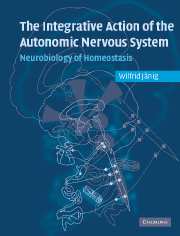Book contents
- Frontmatter
- Contents
- Foreword
- Preface
- List of abbreviations
- Introduction
- Part I The autonomic nervous system: functional anatomy and visceral afferents
- Part II Functional organization of the peripheral autonomic nervous system
- Part III Transmission of signals in the peripheral autonomic nervous system
- Chapter 6 Impulse transmission through autonomic ganglia
- Chapter 7 Mechanisms of neuroeffector transmission
- Part IV Central representation of the autonomic nervous system in spinal cord, brain stem and hypothalamus
- References
- Index
Chapter 6 - Impulse transmission through autonomic ganglia
Published online by Cambridge University Press: 10 August 2009
- Frontmatter
- Contents
- Foreword
- Preface
- List of abbreviations
- Introduction
- Part I The autonomic nervous system: functional anatomy and visceral afferents
- Part II Functional organization of the peripheral autonomic nervous system
- Part III Transmission of signals in the peripheral autonomic nervous system
- Chapter 6 Impulse transmission through autonomic ganglia
- Chapter 7 Mechanisms of neuroeffector transmission
- Part IV Central representation of the autonomic nervous system in spinal cord, brain stem and hypothalamus
- References
- Index
Summary
Postganglionic neurons are the final autonomic motoneurons. Their cell bodies are aggregated in peripheral autonomic ganglia. They receive synaptic input from preganglionic neurons and in some ganglia (notably sympathetic prevertebral ganglia) from peripheral neurons of the enteric nervous system and from peptidergic spinal afferent fibers. As already mentioned in Chapter 1, most sympathetic ganglia are located at distance from their target cells and parasympathetic ganglia are located close to their targets.
Sympathetic ganglia have fascinated investigators since ancient times. It was believed that these structures are “little brains,” which integrate, carry and distribute the “animal spirits” from the brain to the periphery, leading to coordinated actions of the peripheral target organs (the “sympathies”) in association with the activity of the brain (Fulton 1949; Pick 1970; Spillane 1981; Karczmar et al. 1986).
However, it turns out that the primary function of most peripheral sympathetic and parasympathetic pathways is to distribute messages to the periphery from relatively small pools of preganglionic neurons to relatively large pools of postganglionic neurons. This particularly applies to the neural regulation of autonomic body functions, which are chiefly under central control, e.g., regulation of systemic blood pressure, thermoregulation, gastrointestinal functions, evacuative functions (micturition, defecation), erection, salivation, pupil diameter etc.
Acetylcholine is released by all preganglionic axon terminals at their synapses in ganglia and the effects of nerve activity are antagonized by blockade of nicotinic acetylcholine receptors.
- Type
- Chapter
- Information
- Integrative Action of the Autonomic Nervous SystemNeurobiology of Homeostasis, pp. 211 - 250Publisher: Cambridge University PressPrint publication year: 2006
- 1
- Cited by



